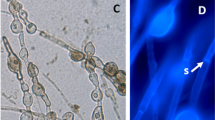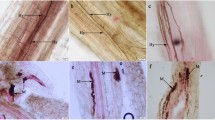Abstract
Fungi with dematiaceous septate hyphae, termed dark septate endophytes (DSE), are common in plant roots, particularly in cold-stressed habitats, but their effects on their host plants remain obscure. Here, we report a study that assessed the effects of six DSE on the growth and nutrient balance of Deschampsia antarctica when plants were supplied with the same amount of nitrogen in organic (casein hydrolysate) or inorganic (ammonium sulphate) form under controlled conditions. After 60 days, the DSE, that had each been isolated from D. antarctica and which analyses of internal transcribed spacer and large subunit regions indicated were similar to members of the Helotiales (Oculimacula yallundae, Mollisia and Tapesia spp.) and unassigned anamorphic ascomycetes, typically had no effect on, or reduced by 33–71%, shoot and root dry weights relative to uninoculated controls when plants had been supplied with nitrogen in inorganic form. In contrast, the DSE usually enhanced shoot and root dry weights by 51–247% when plants had been supplied with organic nitrogen. In the presence of inorganic nitrogen, only sporadic effects of DSE were recorded on shoot and root nitrogen or phosphorus concentrations, whereas in the presence of organic nitrogen, three to six of the DSE isolates increased shoot and root nitrogen and phosphorus contents. Most of the isolates decreased the phosphorus concentrations of shoots and roots when plants had been supplied with nitrogen in organic form. Our data suggest that DSE are able to mineralise peptides and amino acids in the rhizosphere, making nitrogen more freely available to roots.



Similar content being viewed by others
References
Addy HD, Piercey MM, Currah RS (2005) Microfungal endophytes of roots. Can J Bot 83:1–13. doi:10.1139/b04-171
Allen SE (1989) Chemical analysis of ecological materials. Blackwell Scientific, Oxford, UK
Azmi OR, Seppelt RD (1997) Fungi of the Windmill Islands, continental Antarctica. Effect of temperature, pH and culture media on the growth of selected microfungi. Polar Biol 18:128–134. doi:10.1007/s003000050167
Bledsoe C, Klein P, Bliss LC (1990) A survey of mycorrhizal plants on Truelove Lowland, Devon Island, N.W.T., Canada. Can J Bot 68:1848–1856
Bonfante P, Perotto S (1995) Strategies of arbuscular mycorrhizal fungi when infecting host plants. New Phytol 130:3–21. doi:10.1111/j.1469-8137.1995.tb01810.x
Caldwell BA, Jumpponen A, Trappe JM (2000) Utilization of major detrital substrates by dark-septate root endophytes. Mycologia 92:230–232. doi:10.2307/3761555
Currah RS, van Dyk M (1986) A survey of some perennial vascular plant species native to Alberta for the occurrence of mycorrhizal fungi. Can Field Nat 100:330–342
Fernando AA, Currah RS (1996) A comparative study of the effects of the root endophytes Leptodontidium orchidicola and Phialocephala fortinii (fungi imperfecti) on the growth of some subalpine plants in culture. Can J Bot 74:1071–1078. doi:10.1139/b96-131
Grace C, Stribley DP (1991) A safer procedure for routine staining of vesicular–arbuscular mycorrhizal fungi. Mycol Res 95:1160–1162. doi:10.1016/S0953-7562(09)80005-1
Haselwandter K, Read DJ (1982) The significance of a root-fungus association in two Carex species of high-alpine plant communities. Oecologia 53:352–354. doi:10.1007/BF00389012
Herrmann W (1990) ‘Microsclerotia’ a mycorrhizal structure? In: Reisinger A, Bresinsky A (eds) Abstracts of the 4th International Mycological Congress. University of Regensburg, Regensburg, p 368
Hewitt EJ (1966) Sand and water culture methods used in the study of plant nutrition. East Malling, UK
Holtom A, Greene SW (1967) The growth and reproduction of Antarctic flowering plants. Philos Trans R Soc Lond B Biol Sci 252:323–337. doi:10.1098/rstb.1967.0021
Jumpponen A, Trappe JM (1998) Dark septate endophytes: a review of facultative biotrophic root-colonizing fungi. New Phytol 140:295–310. doi:10.1046/j.1469-8137.1998.00265.x
Jumpponen A, Mattson K, Trappe JM (1998) Mycorrhizal functioning of Phialocephala fortinii with Pinus contorta on glacier forefront soil: interactions with soil nitrogen and organic matter. Mycorrhiza 7:261–265. doi:10.1007/s005720050190
Kerry E (1990) Effects of temperature on growth rates of fungi from Subantarctic Macquarie Island and Casey, Antarctica. Polar Biol 10:293–299
Kielland K (1994) Amino acid absorption by Arctic plants: implications for plant nutrition and nitrogen cycling. Ecology 75:2373–2383. doi:10.2307/1940891
Koch R (1882) Über die Milzbrandimpfung. Eine Entgegnung auf den von Pasteur in Genf gehaltenen Vortrag. Fischer, Berlin, Germany
Kohn LM, Stasovski E (1990) The mycorrhizal status of plants at Alexandra Fiord, Ellesmere Island, Canada, a high Arctic site. Mycologia 82:23–35. doi:10.2307/3759959
Laursen GA, Treu R, Seppelt RD, Stephenson SL (1997) Mycorrhizal assessment of vascular plants from subantarctic Macquarie Island. Arct Alp Res 29:483–491. doi:10.2307/1551996
Mandyam K, Jumpponen A (2005) Seeking the elusive function of the root-colonising dark septate endophytic fungi. Stud Mycol 53:173–189
McGonigle TP, Miller MH, Evans DG, Fairchild GL, Swann JA (1990) A new method which gives an objective measure of colonization of roots by vesicular–arbuscular mycorrhizal fungi. New Phytol 155:495–501. doi:10.1111/j.1469-8137.1990.tb00476.x
Mullen RB, Schmidt SK, Jaeger CH (1998) Nitrogen uptake during snowmelt by the snow buttercup, Ranunculus adoneus. Arct Alp Res 30:121–125. doi:10.2307/1552126
Newsham KK (1999) Phialophora graminicola, a dark septate fungus, is a beneficial associate of the grass Vulpia ciliata ssp. ambigua. New Phytol 144:517–524. doi:10.1046/j.1469-8137.1999.00537.x
Newsham KK, Upson R, Read DJ (2009) Mycorrhizas and dark septate endophytes in polar regions. Fungal Ecol 2:10–20. doi:10.1016/j.funeco.2008.10.005
Peterson RL, Wagg C, Pautler M (2008) Associations between microfungal endophytes and roots: do structural features indicate function? Can J Bot 86:445–456
Read DJ, Haselwandter K (1981) Observations on the mycorrhizal status of some alpine plant communities. New Phytol 88:341–352. doi:10.1111/j.1469-8137.1981.tb01729.x
Roberts P, Newsham KK, Bardgett RD, Farrar JF, Jones DL (2009) Vegetation cover regulates the quantity, quality and temporal dynamics of dissolved organic carbon and nitrogen in Antarctic soils. Polar Biol. doi:10.1007/s00300-009-0599-0
Schadt CW, Mullen RB, Schmidt SK (2001) Isolation and phylogenetic identification of a dark-septate fungus associated with the alpine plant Ranunculus adoneus. New Phytol 150:747–755. doi:10.1046/j.1469-8137.2001.00132.x
Smith SE, Read DJ (2008) Mycorrhizal symbiosis, 3rd edn. Academic, London
Stoyke G, Currah RS (1991) Endophytic fungi from the mycorrhizae of alpine ericoid plants. Can J Bot 69:347–352. doi:10.1139/b91-047
Treu R, Laursen GA, Stephenson SL, Landolt JC, Densmore R (1996) Mycorrhizae from Denali National Park and Preserve, Alaska. Mycorrhiza 6:21–29. doi:10.1007/s005720050101
Upson R, Newsham KK, Read DJ (2008) Root–fungal associations of Colobanthus quitensis and Deschampsia antarctica in the maritime and sub-Antarctic. Arct Antarct Alp Res 40:592–599. doi:10.1657/1523-0430(07-057)[UPSON]2.0.CO;2
Upson R, Newsham KK, Bridge PD, Pearce DA, Read DJ (2009) Taxonomic affinities of dark septate root endophytes of Colobanthus quitensis and Deschampsia antarctica, the two native Antarctic vascular plant species. Fungal Ecol (in press)
Usuki F, Narisawa K (2007) A mutualistic symbiosis between a dark septate endophytic fungus, Heteroconium chaetospira, and a nonmycorrhizal plant, Chinese cabbage. Mycologia 99:175–184. doi:10.3852/mycologia.99.2.175
Väre H, Vestberg M, Eurola S (1992) Mycorrhiza and root associated fungi in Spitsbergen. Mycorrhiza 1:93–104. doi:10.1007/BF00203256
Wilcox HE, Wang CJK (1987) Mycorrhizal and pathological associations of dematiaceous fungi in roots of 7-month-old tree seedlings. Can J Res 17:884–889. doi:10.1139/x87-140
Wu L, Guo S (2008) Interaction between an isolate of dark-septate fungi and its host plant Saussurea involucrata. Mycorrhiza 18:79–85. doi:10.1007/s00572-007-0159-9
Zijlstra JD, Van't Hof P, Baar J, Verkley GJM, Summerbell RC, Paradi I, Braakhekke WG, Berendse F (2005) Diversity of symbiotic root endophytes of the Helotiales in ericaceous plants and the grass Deschampsia flexuosa. Stud Mycol 53:147–162
Acknowledgements
Financial support was provided by a research studentship to RU awarded by the Natural Environment Research Council through the Antarctic Funding Initiative (award no. NER/G/S/2000/00318). Bob Keen analysed N and P concentrations of plant material. Paul Bridge kindly assisted with sequence analyses and two anonymous referees supplied helpful comments. All are gratefully acknowledged.
Author information
Authors and Affiliations
Corresponding author
Rights and permissions
About this article
Cite this article
Upson, R., Read, D.J. & Newsham, K.K. Nitrogen form influences the response of Deschampsia antarctica to dark septate root endophytes. Mycorrhiza 20, 1–11 (2009). https://doi.org/10.1007/s00572-009-0260-3
Received:
Accepted:
Published:
Issue Date:
DOI: https://doi.org/10.1007/s00572-009-0260-3




